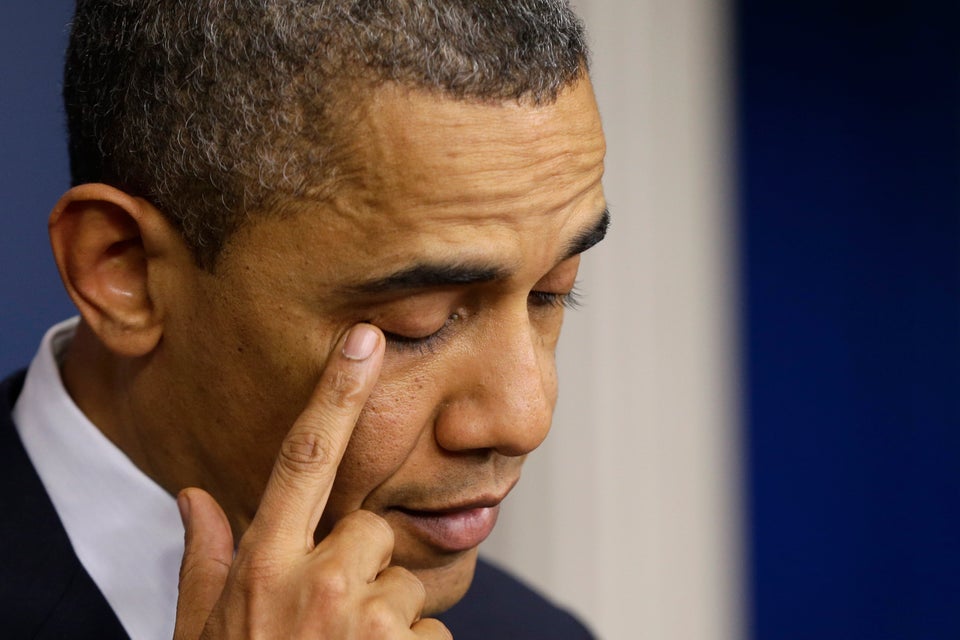
WASHINGTON -- Days before the mass shooting at Sandy Hook Elementary, a boy in Milwaukee confessed to one of his teachers that he had been troubled by voices and delusions. The voices were insisting that he do harm, that he shoot people.
He told the teacher that he had access to a gun at home. He said that he was prepared to bring the gun to school.
This is a scenario that unfolds thousands of times every year across the U.S. It may not involve a school like the high school in Milwaukee or an elementary school in Newtown, Conn. But the catalysts are all hauntingly familiar -- isolation and a troubled teen or young adult in crisis.
Friday's massacre at Sandy Hook Elementary has drawn considerable attention to gun control, with politicians pondering another assault weapons ban, a potential curb on high-capacity magazines, and background checks at gun shows. On Wednesday, President Barack Obama announced the formation of a task force to address the gun issue, which he vowed would not be like other Washington commissions. He said he expects concrete proposals on his desk in January.
Less attention has been focused on forging a better policy on mental health care for at-risk kids. Obama devoted a line to the topic while announcing his gun task force. But mental health legislation may be an easier fix and an easier sell to Congress.
There are ways of preventing more Sandy Hooks or Auroras. The solutions are out there, and many have long been in practice.
That Milwaukee teacher did not call the police. Nor did the teacher ignore the boy. The high school knew exactly how to get the teen immediate help.
School officials dialed Milwaukee's Mobile Urgent Treatment Team, recalled its director, Dr. Chris Morano.
"We knew this was a high risk," Morano explained. His team went to the school, where they assessed the boy on the spot. With the mother's help, the team's clinicians surrounded him with services. He was temporarily hospitalized and began taking medication to help beat back his inner demons, hush his impulsiveness and stamp out his turn-on-a-dime aggressiveness. He and his family began developing a treatment plan with county workers.
The team then assigned him a sort of mental-health bodyguard as someone he or his mother can call 24 hours a day, Morano said. The boy would continue getting services for as long as needed.
Morano's team is just one of the entry points into Milwaukee County's social services program, known as Wraparound Milwaukee.
The program, started in 1995, aims to treat the city's most vulnerable -- children and adolescents with deep emotional disorders who have been swept up in foster care or entangled in the juvenile justice system. For the roughly 550 youth and family members it serves every year, Wraparound Milwaukee provides coordinated services and therapies with one catch: Families -- not bureaucrats -- lead the treatment plans.
Bruce Kamradt, Wraparound Milwaukee's director, explained the philosophy to HuffPost in February. "It's around strengths and needs of kids," he said. "Better we plan this together. We'll look at family needs too. If the youth problem is he's in a gang and the mother really needs to get out of this neighborhood, we may find alternative housing. If she needs a job, we'll try to find a job for her. We're going to focus not only on the kid's need but the family's need."
Morano agreed. "Our innovation is that we go to the community, we go to families," he said. He called parents the "X Factor." "How the parent or caregiver is handling the stress of the trauma. This, to me, is the single most important factor in how well a child will adjust in the aftermath," he explained. "Parents have to handle their own stress and anxiety, appear as confident and assured as they can. ... This is vital in helping kids feel good again."
Wraparound Milwaukee also serves an additional 350 kids who are not attached to the courts, Morano said. The aim is to keep those kids out of the judicial system. "We recognized that it was vital to provide as early and as preventative services as possible," Morano said.
Once they get a sense of the family's needs, Wraparound Milwaukee matches the family with service providers. As Kamradt suggested, the program prides itself on being flexible and not offering the same old individual therapies. It all sounds pie-in-the-sky -- empowering families to stabilize their own children through government agencies and nonprofits. Despite the odds, the ideas have taken root. State and county data analyzed by Kamradt's team show that of 411 new youth enrolled from October 2009 to July 31, 2010, only 11.9 percent committed new offenses. Its 2011 annual report shows high rates of school attendance, stable families, and satisfaction among families and kids.
The innovations are not under-publicized. Wraparound Milwaukee was the subject of a PBS documentary. In 2009, the Harvard Kennedy School of Government gave the program an an innovator award. It's become a national model.
"With respect to this most recent tragedy, I have to to tell you that in Milwaukee we've done a tremendous turnaround," Morano said.
It is a turnaround not widely enjoyed elsewhere. Too many jurisdictions' mental health budgets are consumed by costly hospitals for the most extreme cases, favoring bed space over prevention programs. "The problem is that right now kids in particular get very poor services nationwide," said Robert Bernstein, president of the Bazelon Center for Mental Health Law, an advocacy organization based in Washington. If you want solid, flexible services, you can get them only after you've been hospitalized multiple times, Bernstein added.
Youth Villages, a nonprofit based in Tennessee that works with a number of states, does in-home services for children. Its stats show that more than 80 percent of kids remain with their family one year after completing the program. More than 80 percent of kids report no arrests. Youth Villages works in 11 states and D.C., yet admissions in 2010 were barely above 4,000.
"There's good science around what you are supposed to do," said Dr. Tim Goldsmith, Youth Villages' chief clinical officer. "There's really no question. People just don't do it. For some it's a lack of knowledge. For some its a lack of skill. For some, it's a lack of funding. When you have a young adult in a mental-health system ... it's going to be the luck of the draw with what you're going to get."
Mississippi has wraparound services. But it's nowhere near full funding and doesn't cover the state equally. "Even with the problems with the wraparound, the number of families who are getting to participate in that is very small," explained Joy Hogge, executive director of Mississippi Families As Allies.
Resources or not, cities and states have found ways to innovate at one of the most common intersections between a person in crisis and government.
In the late '80s, the Memphis Police Department decided it needed a better way to deal with these residents. After one confrontation ended in a fatal police-involved shooting, the department created the Crisis Intervention Team model. Along with training for rank-and-file cops, the department developed what amounts to a mental-health version of a SWAT team of officers who go through more intensive trainings.
Memphis residents are no longer afraid to call the police when a loved one is having problems. In 1988, Crisis Intervention Team officers fielded 3,000 calls for service. They now receive roughly 12,000 calls per year. Dozens of police jurisdictions have adopted the program, from Georgia to Seattle to D.C. "There are a lot of officers who are willing to get this training," explained Philip Eure, executive director of D.C.'s Office of Police Complaints. "It's a way of sensitizing people on the front lines."
When judges in Washington noticed that their courtrooms were seeing too many mentally-ill residents charged with minor offenses, they created what's called mental health community court.
One study from Georgetown University Law Center and North Carolina State University noted that five such courts showed reductions in recidivism at least during a defendant's interaction with the courts. Two courts showed reductions two years after the defendant left the court system. The study, which looked at D.C. Superior Court's program, reported that defendants said they had positive experiences and strongly identified with the court's goals.
Magistrate Judge Joan Goldfrank presides over the juvenile version of the court. At least 50 kids have completed the program since the court began about two years ago. She said it has been a success because it makes sure kids get promised services and it empowers parents. "I see kids and parents that can actually have a conversation with each other," Goldfrank told HuffPost. "There's a lot of anger for lots of reasons by many of the kids ... I try to meet the kids where they are."
Eddie Ferrer of DC Lawyers for Youth has had two clients in Goldfrank's courtroom, which he called "fantastic." For one client in particular, he said, the court made a "world of difference." "One of the main reasons it works is because there is meaningful services being provided that try to address the core issue as to why that young person is acting out," he said.
Other juvenile clients aren't so lucky. Ferrer said he has clients who have been waiting six to nine months and still have not received quality mental health services.
The need doesn't go away. Back in Milwaukee, Morano said he gets calls from high schools all day long. Earlier this week, a kid walked into his office with a care coordinator. He was struggling with violent hallucinations. "He was so distraught by what he was thinking and experiencing," Morano said. "He couldn't bring himself to tell me the details. But he wanted help."
His team, Morano said, also assessed a youth who talked about wanting to replicate Sandy Hook.
"He gestured with his hands about shooting people in class," Morano said.

